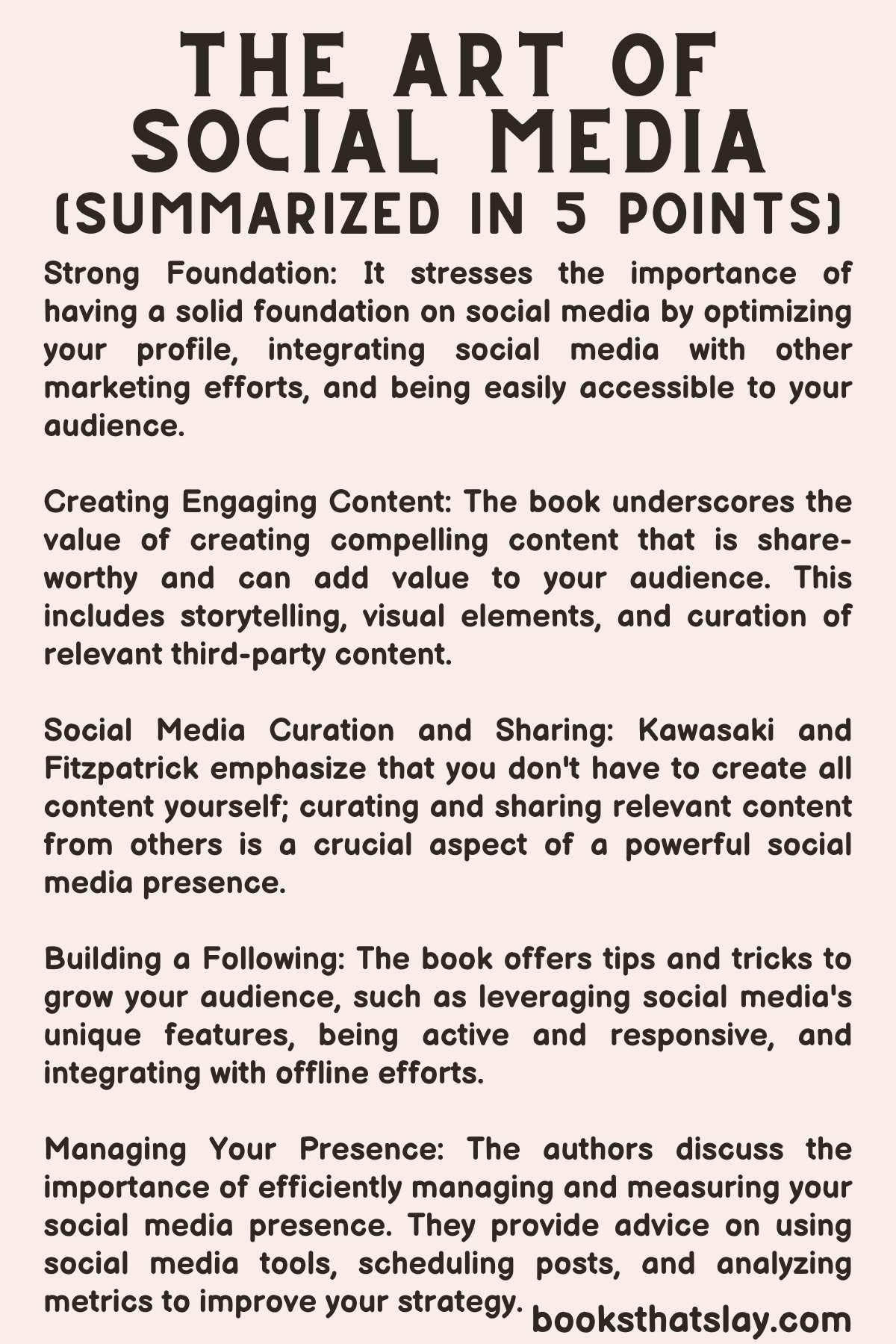The Art of Social Media | Book Summary
“The Art of Social Media: Power Tips for Power Users,” written by Guy Kawasaki and Peg Fitzpatrick, is an insightful, instructive, and practical guide that provides in-depth advice for enhancing one’s skills on social media platforms. While the book was published in 2014, its principles hold up well and can still provide useful guidance in today’s world.
The Art of Social Media Summary
The book opens with a discussion of the fundamentals of social media, emphasizing the importance of understanding one’s audience and tailoring content to fit their needs and interests. This includes insights on topics such as developing an appealing social media profile, refining one’s online presence, and setting the right tone and voice for each platform.
Following this, the authors delve into specifics, providing practical advice for each of the major social media platforms, including Facebook, Twitter, LinkedIn, Pinterest, Google+, and Instagram.
They highlight strategies for optimizing profiles, maximizing engagement, creating and sharing high-quality content, and understanding algorithms that affect visibility and reach.
Next, the book delves into the art of developing a social media strategy.
Kawasaki and Fitzpatrick emphasize the importance of setting clear, achievable goals, scheduling content, using analytics to gauge success, and adjusting strategies based on performance. They explain the need to engage with followers, respond to comments, and cultivate a vibrant and engaged online community.
The authors also discuss how to build an audience from scratch, providing tips on leveraging the power of influencers, creating and sharing viral content, and implementing strategic social media campaigns. They cover aspects of networking, promoting events, product launches, and leveraging social media for customer service.
In later chapters, the authors explore more advanced topics, such as managing and optimizing your content across multiple platforms, using various tools for analytics and scheduling, and how to navigate social media advertising.
They also discuss the emerging trends and changes in the social media landscape, providing readers with foresight into what’s to come.
Throughout the book, Kawasaki and Fitzpatrick highlight the importance of authenticity, engagement, and creating value for followers. They encourage readers to approach social media not just as a platform for promotion, but as a space for dialogue, community-building, and meaningful interaction.

What can you learn from the book?
1. Lesson 1: Crafting a Unique, Consistent Social Media Identity
The book underscores the significance of portraying a consistent image across various platforms, which helps in creating an impactful, long-lasting impression.
This includes maintaining a uniform tone of voice, color scheme, and graphics, along with using the same profile picture and username across platforms to ensure easy recognizability.
For instance, Nike maintains its iconic “Just Do It” tagline and swoosh logo across all social media channels, thereby crafting a distinctive and recognizable identity.
2. Lesson 2: Importance of Quality Content Over Quantity
It’s crucial to share content that is valuable, engaging, and relevant to your audience.
Each post should serve a purpose, be it educating the audience, inspiring them, solving their problems, or entertaining them. Bombarding followers with incessant posts that lack substance can lead to decreased engagement or even loss of followers.
Companies like Apple have mastered this technique by posting infrequently but ensuring that each post is visually striking, innovative, and packed with value.
3. Lesson 3: Optimize for Each Platform
The authors emphasize that each social media platform has a unique ecosystem and audience behavior.
What works on Instagram might not work on LinkedIn. Therefore, it’s important to tailor your strategy for each platform.
Understanding the strengths, weaknesses, opportunities, and threats (SWOT) of each platform and leveraging that understanding can enhance your social media performance.
A good example of this can be TED Talks, which leverages the video-friendly nature of YouTube for comprehensive talks, while using Twitter for quick insights and updates.
4. Lesson 4: Engage with Your Audience Regularly
Regular interactions with followers promote a sense of community, build trust, and encourage brand loyalty.
This could be in the form of responding to comments, recognizing user-generated content, or hosting interactive sessions like Q&A’s or live videos.
Airbnb, for instance, excels in engaging with its audience by actively responding to comments and regularly featuring user-generated content, which helps them create a strong community of travelers and hosts.
Final Thoughts
The Art of Social Media serves as an essential guide for anyone looking to leverage social media for personal or professional use, from beginners to seasoned marketers and influencers.
It offers clear, actionable, and proven strategies that can be applied to enhance any social media presence.
Check out our other summaries
The Last Lecture | Book Summary
A non-fiction book by Randy Pausch, a professor at Carnegie Mellon University, who was diagnosed with terminal pancreatic cancer. The book is based on a lecture he gave, often referred to as the “last lecture,” as it was his final public talk before his death.
The Tipping Point | Book Summary
Discover the captivating power of the “tipping point” in Malcolm Gladwell’s bestseller! Unravel the secrets behind trends, behaviors, and ideas as they spread like wildfire, shaping the world we live in. Prepare to see selling and influencing in a whole new light!
The Power of Habit | Book Summary
Talks in detail about the science behind habit creation and its reformation via real-life examples and practical applications. Also, provides readers with the knowledge and tools necessary to reconstruct their habits in beneficial ways.
So Good They Can’t Ignore You | Book Summary
Understand the fact that following your passion might just not be the best option for you. What Cal Newport recommends is a process/technique that is more realistically aligned.
The Speed of Trust | Book Summary
A groundbreaking, paradigm-shifting book by Stephen M.R. Covey that articulates that trust is not just a social virtue, but a quantifiable and actionable variable.